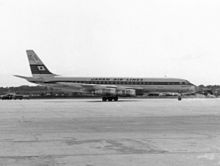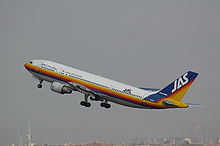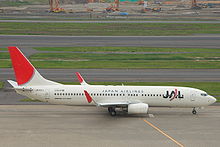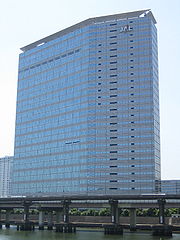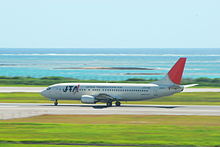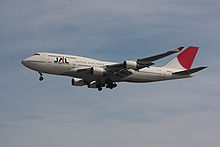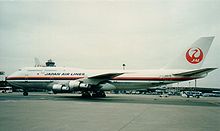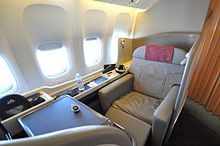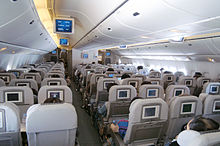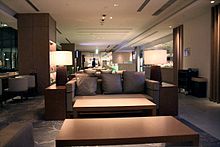- Japan Airlines
-
Not to be confused with Air Japan, the charter carrier.
Japan Airlines
日本航空 (Nihon Kōkū)
IATA
JLICAO
JALCallsign
JAPANAIRFounded August 1, 1951 Commenced operations October 25, 1951 Hubs Focus cities Frequent-flyer program Airport lounge - Diamond Premier Lounge
- JAL First Class Lounge
- Sakura Lounge
Alliance Oneworld Subsidiaries - Hokkaido Air System (HAC)
- J-Air (JLJ)
- JAL Express (JEX)
- Japan Air Commuter (JAC)
- Japan Transocean Air (JTA)
- Ryukyu Air Commuter (RAC)
Fleet size 133 (+54 orders, 20 options) Destinations 103 Company slogan Dream Skyward Parent company Enterprise Turnaround Initiative Corporation of Japan (100%) Headquarters Shinagawa, Tokyo, Japan Key people - Kazuo Inamori (Chairman)
- Masaru Onishi (President)
Website www.jal.com Japan Airlines Co., Ltd. (JAL) (日本航空株式会社 Nihon Kōkū Kabushiki-gaisha) is an airline headquartered in Shinagawa, Tokyo, Japan.[1] It is the flag carrier of Japan and its main hubs are Tokyo's Narita International Airport and Tokyo International Airport (Haneda Airport), as well as Nagoya's Chūbu Centrair International Airport and Osaka's Kansai International Airport. The airline and four of its subsidiaries (J-Air, JAL Express, JALways, and Japan Transocean Air) are members of the Oneworld airline alliance.
JAL group companies include Japan Airlines for international and domestic services; JALways for international leisure services; JAL Express for international and domestic low-cost services; Hokkaido Air System, J-Air, Japan Air Commuter, Japan Transocean Air and Ryukyu Air Commuter for domestic feeder services; and JAL Cargo for cargo and mail services. JAL group operations include scheduled and non-scheduled international and domestic passenger and cargo services to 220 destinations in 35 countries worldwide, including codeshares. The group has a fleet of 279 aircraft. In the fiscal year ended March 31, 2009, the airline group carried over 52 million passengers and over 1.1 million tons of cargo and mail.
JAL was established in 1951 and became the national airline of Japan in 1953. After over three decades of service and expansion, the airline was fully privatized in 1987. In 2002, the airline merged with Japan Air System, Japan's third-largest airline and became the sixth largest airline in the world by passengers carried. The airline filed for bankruptcy protection on January 19, 2010, after losses of nearly ¥100 billion in a single quarter.
Contents
History
Regulated era
Japan Air Lines Co., Ltd. was established on August 1, 1951, with the government of Japan recognizing the need for a reliable air transportation system to help Japan grow in the aftermath of the World War II. The airline was founded with an initial capital of ¥100 million; and its headquarters located in Ginza, Chūō, Tokyo. Between August 27 and August 29, the airline operated invitational flights on a Douglas DC-3 Kinsei, leased from Philippine Airlines. On October 25, Japan's first post-war domestic airline service was inaugurated, using a Martin 2-0-2 aircraft, named Mokusei, and crew leased from Northwest Airlines. On August 1, 1953, the Diet of Japan passed the Japan Air Lines Company Act (日本航空株式会社法 Nihon Kōkū Kabushiki-gaisha Hō), forming a new state-owned Japan Air Lines on October 1, which assumed all assets and liabilities of its private predecessor.[2][3][4][5] On February 2, 1954, the airline began its first international service, carrying 18 passengers from Tokyo to San Francisco. The flight was operated by a Douglas DC-6B named City of Tokyo, made stops at Wake Island and Honolulu before arriving in San Francisco.[2][5][6][7] To this day, the flights between Tokyo and San Francisco are still designated as Japan Airlines Flight 1 and 2, to commemorate its first international service.[8] The airline, in addition to the Douglas DC-3, Douglas DC-6B and Martin 2-0-2s, operated Douglas DC-4 and Douglas DC-7C during the 1950s.[2]
JAL introduced its first jet aircraft, the Douglas DC-8, in 1960
In 1960, the airline received its first jet, a Douglas DC-8, and entered service to Seattle and Hong Kong. Soon after, it decided to re-equip the fleet, exclusively using jet aircraft. During the 1960s, many new international destinations were established, including London, Moscow, New York, Paris and Pusan.[2][9][10] By 1965, Japan Air Lines was headquartered in the Tokyo Building in Marunouchi, Chiyoda, Tokyo.[11] In 1972, under the 45/47 system (45/47体制 yon'go-yonnana taisei), the so-called "aviation constitution" enacted by the Japanese government, JAL was granted flag carrier status to operate international routes. The airline was also designated to operate domestic trunk routes in competition with All Nippon Airways and Toa Domestic Airlines.[10] The signing of Civil Air Transport Agreement between the People's Republic of China and Japan on April 20, 1974, caused the suspension of air route between the Republic of China (Taiwan) and Japan on April 21. A new subsidiary, Japan Asia Airways, was established on August 8, 1975, and air services between the two countries were restored on September 15. During the 1970s, the airline bought the Boeing 727, Boeing 747, Convair 880 and McDonnell Douglas DC-10 to accommodate its growing routes within Japan and to other countries.[9][12]
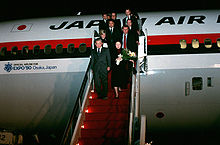 Former Japanese Prime Minister Noboru Takeshita deplanes from a JAL McDonnell Douglas DC-10 while on a state visit to the United States in 1989
Former Japanese Prime Minister Noboru Takeshita deplanes from a JAL McDonnell Douglas DC-10 while on a state visit to the United States in 1989
In the 1980s, the airline performed special flights for the Crown Prince Akihito and Crown Princess Michiko of Japan, Pope John Paul II and for Japanese prime ministers, until the introduction of the dedicated government aircraft using two Boeing 747-400, operated as Japanese Air Force One and Japanese Air Force Two. During that decade the airline introduced new Boeing 747-100SR, Boeing 747-SUD and Boeing 767 jets to the fleet, and retired the Boeing 727s and Douglas DC-8s.[13]
By 1965, over half of the JAL's revenue was being generated by transpacific routes to the United States, and the airline was further lobbying the United States for fifth freedom rights to fly transatlantic routes from the East Coast.[14] In 1978 and 1984, JAL started flights to São Paulo and Rio de Janeiro, respectively, via Anchorage and San Juan; the stopover was changed to Los Angeles in the 1980s-1990s, and then to New York's John F. Kennedy International Airport in 1999.[15] Through 2009, the airline operates fifth freedom flights between New York and São Paulo; and between Vancouver and Mexico City.[16]
Deregulated era
Japan began considering airline deregulation in the late 1970s, with the government announcing the abandoning of the 45/47 system in 1985.[17] In 1987, Japan Airlines was completely privatized, and the other two airlines in Japan, All Nippon Airways (ANA) and Japan Air System (JAS), were permitted to freely compete with JAL on domestic and international routes. Increased competition resulted in changes to the airline's corporate structure, and it was reorganized into three divisions: international passenger service, domestic passenger service, and cargo (including mail) service, and increased marketing efforts were realized.[10][13]
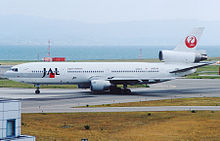 JAL McDonnell Douglas DC-10 in 1989 to 2002 livery
JAL McDonnell Douglas DC-10 in 1989 to 2002 livery
Japan Airlines began the 1990s with flights to help evacuate Japanese citizens from Iraq before the start of the Gulf War. In October 1990, Japan Air Charter was established,[13] and in September 1996 an agreement with The Walt Disney Company was announced, making Japan Airlines the official airline of Tokyo Disneyland. JAL Express was established in April 1997, with Boeing 737 aircraft.[18] In the 1990s the airline encountered further economic difficulties stemming from recessions in the United States and United Kingdom, plus a domestic downturn. Following years of continuous profit since 1986, the airline began to post operating losses in 1992. Cost-cutting initiatives, including the formation of the low-cost JAL Express domestic subsidiary and the transfer of tourist operations to JALways (the successor to Japan Air Charter), helped return the airline to profitability in 1999.[10]
In 1997, the airline flew Japanese prime minister Ryutaro Hashimoto to Peru to help negotiate in the Japanese embassy hostage crisis. Japan Airlines further placed orders for Boeing 777s during the 1990s, allowing for fleet renewal. It was one of eight airlines which participated in the Boeing 777 design process, shaping the resulting design to their specifications.[19]
JAS merger
In 2001, Japan Air System and Japan Airlines agreed to merge; and on October 2, 2002, they established a new holding company called Japan Airlines System (日本航空システム Nihon Kōkū Shisutemu), forming a new core of the JAL Group. Aircraft liveries were changed to match the design of the new JAL Group. At that time the merged group of airlines was the sixth largest in the world by passengers carried.[20]
On April 1, 2004, JAL changed its name to Japan Airlines International and JAS changed its name to Japan Airlines Domestic. JAS flight codes were changed to JAL flight codes, JAS check-in desks were refitted in JAL livery and JAS aircraft were gradually repainted. On June 26, 2004, the parent company Japan Airlines System was renamed to Japan Airlines Corporation.[21][22]
Following the merger, two companies operated under the JAL brand: Japan Airlines International (日本航空インターナショナル Nihon Kōkū Intānashonaru) and Japan Airlines Domestic (日本航空ジャパン Nihon Kōkū Japan). Japan Airlines Domestic had primary responsibility for JAL's large network of intra-Japan flights, while JAL International operated both international and trunk domestic flights. On October 1, 2006, Japan Airlines International and Japan Airlines Domestic merged into a single brand, Japan Airlines International.[21][23]
The airline applied to join Oneworld on October 25, 2005. Japan Airlines claimed that its Oneworld membership would be in the best interests of the airline's plans to further develop the airline group and its strong commitment to provide the very best to its customers.[24] Japan Airlines, together with Malév and Royal Jordanian, joined the alliance on April 1, 2007.[25]
On April 1, 2008, JAL merged the operations of its subsidiary Japan Asia Airways (JAA) into JAL mainline operations. JAA had operated all JAL group flights between Japan and Taiwan between 1975 and 2008 as a separate entity due to the special political status of Taiwan.[26]
Restructuring
In 2009, Japan Airlines suffered steep financial losses, despite remaining Asia's largest airline by revenue.[27] As a result, the airline embarked on staff cuts and route cutbacks in an effort to reduce costs.[27] The carrier also received a ¥100 billion credit line from the Japanese government that year.[27]
Partner airline proposals
In September 2009, Japan's Ministry of Land, Infrastructure, Transport and Tourism formed a task force aimed at aiding a corporate turnaround at JAL, which examined cost-cutting and strategic partnership proposals.[28] Members of the task force expressed an interest in merging JAL with ANA, which would create a single larger international airline and replace Japan Airlines International; however, media reports suggested that this proposal would be opposed by ANA given its comparatively better financial performance as an independent carrier.[28] The task force also examined possible partnerships with foreign carriers.[28]
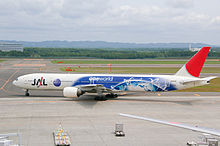 JAL Boeing 777-300 (JA8941) with special Oneworld livery
JAL Boeing 777-300 (JA8941) with special Oneworld livery
By September 2009, JAL was considering allowing Delta Air Lines to acquire a majority equity stake in JAL. Delta was part of the SkyTeam alliance, a rival to the Oneworld alliance in which JAL participated.[29] JAL was also in talks with Skyteam member Air France-KLM and with JAL's existing Oneworld partner American Airlines regarding potential equity investments in JAL.[30][31] JAL was already set on cutting 5,000 jobs as part of its restructuring plan.[32]
The Ministry of Land, Infrastructure, Transport and Tourism supported the Delta deal because Delta had an extensive global network and had the largest Japanese operation of any foreign airline, an operation which it had inherited through its merger with Northwest Airlines.[33] MLIT also supported a transaction with Air France-KLM because it was a "healthier company" than American.[34] Korean Air, also a SkyTeam member and one of JAL's codeshare partners, was also in talks with JAL on the issue.[27]
American also planned to team up with other Oneworld alliance members to recapitalise JAL. Executives from American, British Airways and Qantas met with executives at JAL to introduce plans of a joint offer.[35] British Airways said that it was attempting to persuade JAL to remain part of Oneworld rather than aligning itself with Delta and SkyTeam.[36] American CEO Gerard Arpey said that American and Oneworld remained committed to a partnership with Japan Airlines, as long as it remained a major international carrier,[37] and reiterated his encouragement for JAL to stay with Oneworld during ceremonies to welcome Mexicana into the alliance.[38]
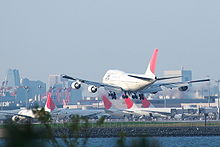 JAL operations at Tokyo International Airport (Haneda Airport)
JAL operations at Tokyo International Airport (Haneda Airport)
In an interview with the Asahi Shimbun on January 1, 2010, regarding opposition to bankruptcy proceedings, JAL president Haruka Nishimatsu stated his preference in forming a partnership with Delta Air Lines over American Airlines.[39] On January 4, the Yomiuri Shimbun reported that JAL and the Japanese government-backed Enterprise Turnaround Initiative Corporation would likely choose to form a business and capital tie-up with Delta, and that JAL would enter SkyTeam as part of the deal. The move, according to the report, would reduce JAL's international flight operations in favor of code-share agreements with Delta. The report also said that American Airlines had begun procedures to end negotiations with JAL.[40] A JAL spokesman denied the report, stating that negotiations with Delta and American were continuing.[41] American also responded, saying that they were still negotiating and that it would be best for Japan and the Japanese people if JAL remained with American and Oneworld.[42] On January 6, American stated that it would be willing to make an investment even if JAL goes into bankruptcy.[43]
On January 7, the Wall Street Journal reported that American Airlines raised its JAL investment offer by $300 million, to $1.4 billion. In separate comments to the press, Delta president Ed Bastian said that Delta was "willing and able to raise additional capital through third-party resources."[44] On the same day, the Business Travel Coalition, a travel group representing 300 international companies, announced their opposition to an alliance between Delta and JAL. Chairman Kevin Mitchell said that such an alliance would likely create a monopoly, totaling 62% of the market share on flights between the United States and Japan. In a letter addressed to Transport Minister Seiji Maehara, the group said that remaining with American would be "obviously best for competition and consumer choice."[45]
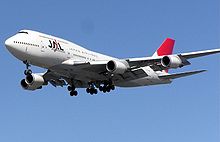 As part of its restructuring, JAL retired all Boeing 747-400 aircraft in 2011, ending 41 years of 747 service.
As part of its restructuring, JAL retired all Boeing 747-400 aircraft in 2011, ending 41 years of 747 service.
Bankruptcy
After weeks of speculation, JAL applied for court protection under the Corporate Rehabilitation Law (the Japanese equivalent of Administration (UK) or a Chapter 11 Bankruptcy (US) filing) on January 19, 2010. JAL expects to receive a ¥300 billion cash injection and have debts worth ¥730 billion waived, in exchange for which it will cut its capital to zero, cut unprofitable routes and reduce its workforce by 15,700 employees—a third of its 47,000 total.[46] JAL's main creditors (Mizuho Corporate Bank, Bank of Tokyo-Mitsubishi UFJ and Sumitomo Mitsui Banking Corporation) originally objected to the bankruptcy declaration, but changed their mind after the Enterprise Turnaround Initiative Corporation of Japan recommended court protection, according to a senior bank official.[47][48] Shares of JAL were delisted from the Tokyo Stock Exchange on February 20, 2010.[49] [50] Kazuo Inamori, founder of Kyocera and KDDI, took over as CEO, while Japan Air Commuter president Masaru Onishi was promoted to president of JAL.[51]
The Mainichi Shimbun reported on January 28 that JAL would announce on February 1 its decision to end its partnership with American Airlines and Oneworld in favor of Delta and SkyTeam.[52] But in a news conference on February 1, JAL president Masaru Onishi said that the new JAL leadership was "seriously reviewing the issue from scratch, without being influenced by previous discussions," and its decision on an alliance partner would be made soon.[53]
On February 7, several news outlets reported that JAL would decide to keep its alliance with American Airlines and end talks with Delta. New JAL CEO Inamori and ETIC officials, according to the reports, decided that switching alliances (from Oneworld to Skyteam) would be too risky and could hinder JAL's ability to turn around the airline quickly.[54] Two days later, JAL officially announced that they would strengthen their partnership with American, including a joint application for antitrust immunity on transpacific routes. The airline would also fortify its relationship with other partners in the Oneworld alliance.[55]
In May, JAL began to see an increase in its passenger numbers by 1.1% year-on-year.[56] In August, it was reported that JAL would cut 19,133 jobs from its workforce of 47,000 by the end of March 2015 – whilst also increasing capacity – in an attempt to make the business viable.[57]
Post-bankruptcy developments
JAL emerged from bankruptcy protection in March 2011. In July, ETIC announced its selection of Nomura Holdings, Daiwa Securities, Mitsubishi UFJ Morgan Stanley, Mizuho Securities and SMBC Nikko Securities to underwrite the sale of its equity stake in JAL, without specifying amounts or dates.[58]
On January 11, 2011, JAL and American announced that they would commence joint venture business operations from April 1, 2011.[59]
In July 2011, Japanese newspapers reported that JAL had agreed to form a low-cost carrier joint venture with Jetstar Airways, the low-cost subsidiary of Qantas.[60]
Corporate affairs and identity
Organization
In addition to its operations under the JAL name, the airline owns six domestic airlines which feed or supplement mainline JAL flights:[61]
- Hokkaido Air System (HAC) – turboprop services in Hokkaido
- J-Air (JLJ) – regional jet services from Tokyo, Nagoya and Osaka
- JAL Express (JEX) – low-cost jet services between secondary cities
- Japan Air Commuter (JAC) – turboprop services in western Japan, mainly including Amami Islands.
- Japan Transocean Air (JTA) – jet services in the Ryukyu Islands
- Ryukyu Air Commuter (RAC) – turboprop services in the Ryukyu Islands
Japan Airlines now in the sponsor of Persija Jakarta.
JALways was the airline's international subsidiary, which handled low-yield flights to resort destinations in Hawaii, Oceania and Southeast Asia.[61]
JALUX Inc., established in 1962, is the airline's procurement business which handles various work for the company, including the JAL SELECTION merchandise and in-flight meals and refreshments; supplies for Blue Sky and JAL-DFS shops; aircraft fuel components, cabin services and in-flight duty-free. JALUX merged with JAS Trading on January 1, 2004, to unify support operations for the JAL group.[62][63][64]
JAL Cargo is the brand of the airline group's freight service and is a member of the WOW cargo alliance with the following products, J Speed, General Cargo and Dangerous Goods.[65] In the fiscal year ended March 31, 2009, the Cargo division carried 500,779 tonnes of freight domestically and 627,213 tonnes of freight internationally.[66]
On April 1, 2011, the airline changed its trade name from Japan Airlines International Co., Ltd (株式会社日本航空インターナショナル Kabushiki-gaisha Nihon Koku Intānashonaru) to Japan Airlines Co., Ltd (日本航空株式会社 Nihon Koku Kabushiki-gaisha).[67][68]
Livery
The JAL livery is called the tsurumaru. It is of a Japanese red-crown crane with its wings extended in full flight. The Tsurumaru JAL logo was created in 1958 by Jerry Huff, the creative director at Botsford, Constantine and Gardner of San Francisco, which had been the advertising agency for Japan Airlines from its earliest days. JAL had used several logos up until 1958. When the airline arranged to buy the new Boeing 747’s, they decided to create a new official logo to announce the inaugural of their jet service world wide.
In the creation of the logo, Huff was inspired by the personal crests of Samurai families. In a book he’d been given,We Japanese, he found pages of crests, including the crane. On his choice of the crane, he writes: “I had faith that it was the perfect symbol for Japan Air Lines. I found that the Crane myth was all positive—it mates for life (loyalty), and flies high for miles without tiring (strength.)” [69] After its creation the livery was in use until 1989 when it was replaced by a livery called the "Arc of the Sun." The livery features the motif of a rising sun on a creamy parchment colored background.[70] JAL is a strong supporter of UNICEF and expresses its support by having a "We Support UNICEF" logo on each aircraft.[71]
JAL is known for adopting special liveries. A Boeing 747 (JA8908) carries an Adidas soccer livery in 2002.[72] Another Boeing 747 (JA8907) is the Matsui Jet, featuring the famous Japanese baseball player Hideki Matsui in 2003.[73] The airline's Boeing 767-300 (JA8253) is the Expo 2005 aircraft.[74] Various aircraft in the JAL fleet carry a Yokoso Japan logo supporting the Visit Japan campaign.[75] During late 2005, Japan Airlines began using a Boeing 777 (JA8941), featuring Japanese actor Shingo Katori on one side, and television series Saiyuki, along with its main character "Goku" on the other side.[76]
JAL is also known for its liveries featuring Tokyo Disneyland and Tokyo DisneySea, as it is the official airline of the Tokyo Disney Resort. They sponsor the attraction Star Jets (not related to past Star Jets fleet with the old tsurumaru livery), which feature a variation of the current livery on the ride vehicles. At one time there were more than six widebody aircraft painted with the special liveries.[77][78]
JALways, whose fleet is entirely made of Boeing 747 aircraft, has painted all of its aircraft with tropical-influenced liveries along with Reso'cha titles.[79] These aircraft are used on charter flights to holiday destinations in the Pacific,[10] such as Hawaii. Reso'cha is a marketing abbreviation for Resort Charter. Reso'cha planes were formerly known as JAL Super Resort Express.[80]
In April 2007, JAL debuted a Boeing 777-300 (JA8941) with a special Oneworld livery to promote the airlines's entry to the global airline alliance.[81] Previously this aircraft carried the Shingo Katori and the Saiyuki television livery.[76] In 2008, JAL repainted a single Boeing 777-200 to have a green rather than red arc on its tail, along with a green origami airplane on the fuselage, and named it the Eco Jet, to highlight the company's efforts to reduce the environmental impact of commercial aviation.[82] In 2009, JAL repainted JA8941 again, as well as a JTA 737-400 (JA8933) to promote Kobukuro and their new album Calling as well as a live concert tour in Okinawa and around Japan. This livery was released officially on July 30, 2009.[83][84][85] It has since then been replaced with a special Doraemon livery.[citation needed]
On September 4, 2010, in conjunction with the Boku no Miteiru Fūkei album, JAL and Arashi (which one of the songs, "Movin' On", is used for a commercial) introduced a new livery featuring the five members of Arashi in the aircraft; the first flight was on the day after on September 5.[86]
On January 19, 2011, Japan Airlines announced a new livery based on the old livery tsurumaru used before 2008, and will be used starting April 1, 2011.[87]
Branding
Landor Associates created JAL's brand identity in 1989. After Japan Airlines and Japan Air System merged, the Tokyo office of Landor and JAL worked together to create a new brand identity. Landor decided to use the "arc of the sun" image. The 2000s rebranding began in April 2002 and completed in April 2004. The brand identity firm designed 300,000 specific items for JAL.[88] JAL announced that it would again change its branding on April 1, 2011.[89]
Destinations
 JAL terminal lobby at Kansai International Airport
JAL terminal lobby at Kansai International Airport Further information: Japan Airlines destinations
Further information: Japan Airlines destinationsJapan Airlines serves 33 international destinations in Asia, the Americas, Europe and Oceania, excluding codeshares. The airline's international hubs are Tokyo's Narita International Airport, Tokyo International Airport in Haneda, Osaka's Kansai International Airport and Osaka International Airport in Itami. The airline group also serves 59 domestic destinations within Japan.[90]
In the fiscal year ended March 31, 2009, the airline introduced or increased services on ten international routes, including between Tokyo (Narita) and New York, and between Osaka (Kansai) and Shanghai; and it ceased operations on four international routes, including between Tokyo (Narita) and Xi'an, and between Osaka (Kansai) and Qingdao. Domestically, JAL suspended 14 routes, including between Sapporo and Okinawa. Additionally, the airline expanded codesharing alliance with fellow Oneworld partners, British Airways and Finnair, and other airlines, including Air France, China Eastern and Jetstar.[91]
Japan Airlines has codeshare agreements, beside OneWorld members, with the following airlines:
- Aeroméxico (SkyTeam)
- Air France (SkyTeam)
- Air New Zealand (Star Alliance)
- Air Tahiti Nui
- Alitalia (SkyTeam)
- China Airlines (SkyTeam)
- China Eastern (SkyTeam)
- China Southern (SkyTeam)
- Emirates
- Jetstar Airways
- Korean Air (SkyTeam)
- Thai Airways International (Star Alliance)
- Transaero
- Vietnam Airlines (SkyTeam)
Fleet
Passenger
 JAL Boeing 747-400D
JAL Boeing 747-400D
 JAL Boeing 777-200
JAL Boeing 777-200
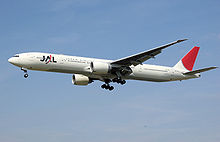 JAL Boeing 777-300ER
JAL Boeing 777-300ER
Japan Airlines operates 121 passenger planes with a mixture of narrow- and wide-body aircraft.[92] The airline operates with three classes of service (First, class J and Economy); two classes of service (class J and Economy); and one class of service (Economy) domestically within Japan. Internationally, it operates with four classes of service (First, Executive, Premium Economy and Economy); two varieties of three classes of service (First, Executive and Economy) or (Executive, Premium Economy and Economy); and two classes of service (Executive and Economy).[93][94][95]
Japan Airlines Fleet Aircraft Total[93] Orders Options Passengers[94][95] Note F J W Y Total Boeing 737-800 12 — — — 20 — 145 165 Domestic, another 28 are operated by JAL Express Boeing 767-300 17 — — — 42 — 219 261 Domestic 30 202 232 International
JA8980 painted in Oneworld liveryBoeing 767-300ER 31 1 — — 30 — 207 237 International Boeing 777-200 15 — — — 50
62
12— 330
326
377380
388
389Domestic
To be phased out
JA771J painted in Oneworld liveryBoeing 777-200ER 11 — — — 56
6340
0149
237245
300International
JA701~703J (JAL Skylux Seat)
JA704~711J (JAL Shell Flat Seat, Premium Economy)Boeing 777-300 7 — — — 62 — 410 472 Domestic Boeing 777-300ER 13 — [96] — 8 77 46 115 246 International
JA731~737J (JAL Sky Sleeper Seat, Premium Economy)
JA738~740J (JAL Suite, Shell Flat Seat, Premium Economy)Boeing 787-8 — 35[96][97] 20[98] — 42 — 144 186[99] First aircraft to be delivered in December 2011[100] McDonnell Douglas MD-90-30 16 — — — 18 — 132 150 Domestic
to be sold to Delta Air LinesTotal 122 36 20 Fleet notes
The Boeing customer code for Japan Airlines is 7x7-x46 for JAL International (pre-merger JAL aircraft) (i.e. 777-246) and 7x7-x89 for JAL Domestic (former JAS aircraft). (i.e. 747-489) [101] The airline is one of the few in the world to operate 10-abreast seating in the Economy cabin of the Boeing 777 fleet, the other airlines include ANA, Air France, China Southern and Emirates. JAL and ANA operate the 10-abreast seating in their Japan domestic fleet only.[102][103][104][105][106]
On December 22, 2004, JAL announced the selection of the Boeing 787 Dreamliner as its next generation medium-size aircraft fleet. The airline is seeking 30 firm deliveries and 20 options; and joined other launch customers to be involved in the aircraft's future development. The airline later increased the firm order to 35 aircraft on April 3, 2007.[97][98]
On June 30, 2005, the airline confirmed an order for six new Boeing 767-300ER aircraft, powered by General Electric CF6-80C2 high-bypass turbofan engines. The three freighter and three passenger models, valued at approximately US$800 million at list prices, were delivered between 2007 and 2008.[107]
On February 22, 2008, it was reported that the airline has been considering the new Airbus A350 made by EADS unit Airbus, the Boeing 787's direct competitor in the medium-size aircraft market. Japan Airlines spokesman Stephen Pearlman said: "We have taken a look at the A350. As far as adding this aircraft to our fleet in future goes, I think it is one of the strong candidates."[108]
Cargo
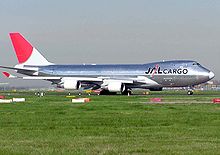 JAL Cargo Boeing 747-400F at London Heathrow Airport
JAL Cargo Boeing 747-400F at London Heathrow Airport
JAL Cargo ended dedicated freighter aircraft operations in October 2010 after more than 30 years of service. It operated both propeller and jet aircraft through the years, most recently Boeing 747-400s (including aircraft converted from passenger to freighter configuration) and Boeing 767-300Fs. Limited cargo activity is now maintained through JAL's passenger aircraft lower deck holds.
Fleet history
JAL Boeing 747-100SR with stretched upper deck in 1987
The airline's last McDonnell Douglas MD-11 J-Bird (JA8582) operated its final flight as Japan Airlines Flight 730 from Hong Kong International Airport to Narita International Airport on October 12, 2004. The aircraft was originally introduced into service on April 1, 1994.[109][110] In addition, the airline operated its last two McDonnell Douglas DC-10 flights on October 31, 2005. One aircraft, JA8543, operated as Japan Airlines Flight 736 from Hong Kong International Airport to Narita International Airport, touched down at 16:05. Another aircraft, JA8541, operated as Japan Airlines Flight 952 from Incheon International Airport to Narita International Airport, touched down at 16:37. This marked the DC-10's last flight with the airline, ending over 30 years of operations for this model.[109]
The airline phased out three Boeing 747-200Fs in the 2008 financial year;[111] and operated its last Boeing 747-300 Classic Jumbo Jet as JALways Flight 73 from Honolulu International Airport to Narita International Airport on July 30, 2009, after 26 years of service to the airline group. The aircraft was met on arrival by the "Father of the 747", Mr Joseph F. "Joe" Sutter.[112] One former JAL 747SR is now being used as a NASA Shuttle Carrier Aircraft.[113] The airline plans to retire all of its Boeing 747 and Airbus A300-600 aircraft by March 2011.[114] The airline retired its last Boeing 747 on March 1, 2011. The last flight was a flight from Honolulu International Airport to Narita International Airport, ending 41 years of service with the Boeing 747.[115]
 JAL Boeing 747-300 in 2008
JAL Boeing 747-300 in 2008
Aircraft that have previously been in service with Japan Airlines are (in alphabetical order):
- Airbus A300-600R
- Beech 18[116]
- Boeing 727-100[117]
- Boeing 737-400[118]
- Boeing 747-100, SR^, 200B, 300, 400[119] *
- Boeing 767-200
- Boeing 767-300F (by JAL Cargo)
- Convair 880[117]
- Douglas DC-3[120]
- Douglas DC-4[120]
- Douglas DC-6B[120] *
- Douglas DC-7C[120] *
- Douglas DC-8-30, 50, 60[117] *
- Falcon 20[116]
- Martin 2-0-2[120]
- McDonnell Douglas DC-10-40
- McDonnell Douglas MD-11
- McDonnell Douglas MD-87
- NAMC YS-11[117]
^ Two 747-SR were converted to SUD (Stretched Upper Deck)
* Also Freighter versions operated by JAL CargoJ-Bird
 JAL MD-11 in J-Bird livery
JAL MD-11 in J-Bird livery
The long haul medium demand international routes of JAL were used by the fleet of J-Birds, McDonnell Douglas MD-11. They were named after birds.[121]
- JA8580 – Tufted puffin
- JA8581 – Fairy Pitta
- JA8582 – Manchurian Crane
- JA8583 – Golden Eagle
- JA8584 – Okinawa Rail
- JA8585 – Mountain Hawk Eagle
- JA8586 – White Stork
- JA8587 – Pryer's Woodpecker
- JA8588 – White Tailed Sea Eagle
- JA8589 – Rock ptarmigan
Star Jet
JAL's Boeing 777 fleet with the tsurumaru livery was called the Star Jet, with each aircraft named after a star.
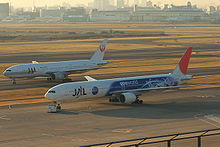 JAL Boeing 777 Star Jet and "Arc of the Sun" livery aircraft
JAL Boeing 777 Star Jet and "Arc of the Sun" livery aircraft
Boeing 777-200 Star Jet[122]
- JA8981 – Sirius
- JA8982 – Vega
- JA8983 – Altair
- JA8984 – Betelgeuse
- JA8985 – Procyon
Boeing 777-300 Star Jet[123]
Flower Jet
In the 1990s JAL introduced the 150 seater Boeing 737-400 to handle domestic route expansion efficiently and economically. The 400 series was equipped with the latest electronic systems and high performance engines. The Boeing 737-400 fleet was called "Flower Jet" as each aircraft was named after a different flower.[124]
Services
Cabin classes
New cabin
JAL Suite First Class
JAL introduced new international First and Executive Class seats: the JAL Suite for First Class, featured a seat 20 percent roomier than the Skysleeper Solo in a 1-2-1 configuration; and the JAL Shell Flat Neo Seat for Executive Class Seasons, a slightly revised version of the original Shell Flat Seat, with a wider seat; expanded center console; and the world's first in-flight photo art exhibit, Sky Gallery. These seats, along with the Premium Economy seats, debuted on Japan Airlines Flights 5 and 6, operated on the Tokyo–New York route on August 1, 2008. It expanded to the Tokyo–San Francisco route on September 13, 2008, and the Tokyo–Chicago and Los Angeles in 2009.[125]
Eight JAL Suites and 77 JAL Shell Flat Neo Seat are installed in each Boeing 777-300ER aircraft, with 46 Premium Economy and 115 Economy seats taking up the rest of the aircraft cabin. The purpose is to improve income yield per passenger, while reducing fuel cost per passenger mile, utilizing the most efficient aircraft available.[126]
International services
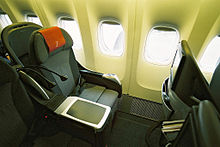 JAL Executive Class Seasons Shell Flat seat
JAL Executive Class Seasons Shell Flat seat
The airline's international services with existing cabins feature the fully reclining First Class Skysleeper Solo or Skysleeper; Executive Class Seasons Shell Flat Seat or Skyluxe Seat; Premium Economy Sky Shell Seat; and Economy Class.[127] The First Class Skysleeper Solo reclines fully and features genuine leather upholstery from Poltrona Frau of Italy.[128] The Executive Class Seasons Shell Flat Seat is a lie-flat design with the ability to lower armrests to the same height as the seat when reclined.[129] Premium Economy is a recent addition, it was first introduced on the Tokyo–London route on December 1, 2007.[130] It features a shell-shaped seat that allows passengers to recline by sliding their seat forward, without having the seat in front intrude when reclining.[131]
Japan domestic services
On Japan domestic services, the airline offers First Class, class J Executive Class and Economy Class.[132] The First Class seat is made from premium genuine leather with a seat width of about 53 cm (21 in) and a seat pitch of about 130 cm (51 in).[133] Class J features ergonomically designed reclining seats that promote relaxation by allowing passengers to move naturally and maintain a balanced posture.[134]
In-flight entertainment
MAGIC
MAGIC, JAL's in-flight entertainment system, supported by the JAL Entertainment Network (JEN), features the latest hit movies and videos, games and audio programs. There are four generations of the MAGIC system: MAGIC-I, MAGIC-II, MAGIC-III, MAGIC-IV and the new MAGIC-V (To be installed on selected Boeing 767-300ER routes) [135] Introduced on December 1, 2007, the MAGIC-III system provides Audio/Video On Demand (AVOD) entertainment to all passengers. The number of movie, music, video and game channels on MAGIC-III was doubled from 57 to 130 by 2008; and it is installed on all seats on Boeing 767-300ER, 777-200ER and 777-300ER aircraft.[136] Aircraft with MAGIC-I and MAGIC-II have movies that automatically start when the AVOD system is turned on—once the aircraft reaches cruise level—and economy class passengers can tune in to watch the movie in progress; and all movies restart upon completion. Executive and First Class passengers have full AVOD control. MAGIC systems also have JAL's duty-free shopping catalogue, including flight crew recommendations and a video of specials available on the flight.[137] MAGIC-V will feature the same entertainment as MAGIC-III, but with a touch screen controller, along with a handset. There will be USB ports for iPod connectivity, and an easier to control handset. (Being introduced on selected Boeing 767-300ER routes in late October).
Aircraft cameras
On most JAL international flights, on-plane cameras are available, either on the wings, the belly or on the tail. When the aircraft is in the pushback; taxi; takeoff; ascent; descent; stacking; landing; and docking phases of flight, all TV's in the cabin automatically tune into the video camera outside the aircraft to provide "Pilot Vision" to the passengers.[138]
Additional media
Skyward, the airline group's inflight magazine, reflecting the company motto of "Dream Skyward". Prior to the merger with JAS, JAL's inflight magazine was called Winds.[139] All of the JAL Group magazines are provided by JALUX.[140]
In June 2006, JAL announced a promotion featuring the Nintendo DS Lite. Between June 1 and August 31, all Executive and First Class passengers would be offered use of Nintendo DS Lites specially manufactured for air travel, with the wireless capabilities of these units were removed in order to conform with airline safety standards.[141]
In-flight catering
Japan Airlines offers meals on intercontinental routes, depending on the cabin class, destination and flight length. Western and Japanese menu selections are typically offered, including seasonal menu selections varied by destination.[142][143] Special meal offerings can be requested in each class during booking, including children's, religious, vegetarian, and other meals.[144]
Sakura Lounge
Sakura Lounge, named after the Japanese word for cherry blossom, is Japan Airlines' signature lounge. In addition, the airline also operates the following international, including First Class Lounge, Sakura Lounge annex and JAL Lounge; and domestic lounges, including Diamond Premier Lounge and JAL Lounge. Access to the lounges depend on the class of travel or the membership status in the JAL Mileage Bank or JAL Global Club.[145][146][147]
The Sakura Lounge offers complimentary beverages, including juice, soda drinks, coffee, tea, mineral water and alcohol drinks; and snacks. A variety of reading materials are also available, such as major, local and sports newspapers; weekly magazines and economy books. Business services include public phones, fax and copy machines; and connect personal computer for internet communication using the wire LAN and the wireless LAN available in the Sakura lounges.[148]
JAL Mileage Bank
JAL Mileage Bank (JMB) is the travel rewards program of JAL Group, including Japan Airlines, JALways, JAL Express, Japan Transocean Air, Japan Air Commuter, Hokkaido Air System and Ryukyu Air Commuter. The program's airline partners also include JAL's Oneworld partners, as well as Air France, China Eastern Airlines and Emirates. For the airline's most frequent flyers, JMB offers Fly On Program, a frequent flyer service status program; and JAL Global Club (JGC), an exclusive club designed for experienced travelers.[149][150]
The JMB program has no membership fee and mileage will be valid to the last day of the 36th month following the month of the flight or transaction date. In addition, if a JMB member does not accumulate mileage within 36 months after becoming a member, or a JMB member's account remains inactive at zero mileage for a consecutive 36 month period, JAL may withdraw or cancel the membership of such member.[149][151]
JMB Fly On Program
The Fly On Program is the frequent flyer service status program and is divided into four membership levels, Crystal, Sapphire, JGC Premier and Diamond, based on the member's travel in the last calendar year. Additionally, a minimum of four JAL Group flights on eligible fare classes are required. Members earn Fly On points on eligible fare classes on JAL Group and Oneworld member airlines. These are used to calculate the member's eligibility for membership renewal, upgrade or downgrade during the membership year. Higher-tiered members are provided with increased travel benefits such as bonus mileage, additional baggage allowance, priority boarding and airport lounge access. There are two phases to the Fly On Program service benefits; one begins after two months following qualification for membership and the other begins from April of the following year. Membership is valid until March 31 of the second year following membership qualification.[152][153]
Crystal
Crystal level is achieved or retained when the member earns 30,000 Fly On Points or boarding more than 30 flights and minimum of 10,000 Fly On Points. Services and benefits after two months of membership qualification include priority waitlisting, 50 percent bonus mileage, airport lounge access for Japan domestic flights with lounge coupons via mileage deduction, priority check-in at Executive Class counters for international flights, JGC counters and priority baggage for class J on JAL Group domestic flights, 10 kg (22 lb) or one piece of extra baggage allowance, priority boarding on international flights, priority airport standby and class J upgrade with class J coupon via mileage deduction. Services and benefits from April of the following year include 10 upgrade points for complimentary flight upgrades. JMB Crystal membership level is equivalent to Oneworld Ruby tier status, which entitles members to Oneworld Ruby benefits when travelling on a Oneworld member airline.[154][155]
Sapphire
Sapphire level is achieved or retained when the member earns 50,000 Fly On Points or boarding more than 50 flights and minimum of 15,000 Fly On Points. Additional services and benefits for Sapphire members after two months of membership qualification include 100 percent bonus mileage, JAL or Sakura Lounge access with one guest when flying on JAL Group airline flights. Priority check-in at First Class counters for international flights and JGC counters for Japan domestic flights, priority baggage, 20 kg (44 lb) or two pieces of extra baggage allowance and access to JAL Fast Security Lane. Additional services and benefits for Sapphire members from April of the following year include 20 upgrade points for complimentary flight upgrades. JMB Sapphire members will be invited to join the JGC, which is dedicated to cater for experienced travelers. JMB Sapphire membership level is equivalent to Oneworld Sapphire tier status, which entitles members to Oneworld Sapphire benefits when travelling on a Oneworld member airline.[155][156]
JGC Premier
 Hotel Nikko Tokyo, part of the Fly On rewards program
Hotel Nikko Tokyo, part of the Fly On rewards program
JGC Premier is achieved or retained when the member earns 80,000 Fly On Points or boarding more than 80 flights and minimum of 25,000 Fly On Points. Additional services and benefits for JGC Premier members after two months of membership qualification include mileage expiry suspension during membership period, First Class and Diamond / Premier Lounge access with one guest when flying on JAL Group airline flights, and priority check-in at First Class counters and priority boarding for both international and domestic flights. Additional services and benefits for JGC Premier members from April of the following year include three complimentary transferable JAL and Sakura Lounge coupons, 30 upgrade points for complimentary flight upgrades, one complimentary JAL Hotels one night stay coupon, five complementary passes to the Century 21 Club and one flower gift coupon. JGC Premier membership level is equivalent to Oneworld Emerald tier status, which entitles members to Oneworld Emerald benefits when travelling on a Oneworld member airline.[155][157]
Diamond
The highest membership level in the Fly On Program of the JAL Mileage Bank. Diamond level is achieved or retained when the member earns 100,000 Fly On Points or boarding more than 120 flights and minimum of 35,000 Fly On Points. Additional services and benefits for Diamond members after two months of membership qualification include 125 percent bonus mileage and any seat award tickets with double mileage deduction. Additional services and benefits for Diamond members from April of the following year include 40 upgrade points for complimentary flight upgrades, two complimentary JAL Hotels one night stay coupons and Century 21 Club membership. JMB Diamond membership level is equivalent to Oneworld Emerald tier status, which entitles members to Oneworld Emerald benefits when travelling on a Oneworld member airline.[155][158]
JAL Global Club
 JAL Global Club logo
JAL Global Club logo
The JAL Global Club is an exclusive club dedicated to cater for JAL Group's most experienced and valuable travelers. Membership is available to JMB members who have earned 50,000 Fly On Points or boarding more than 50 flights and minimum of 15,000 Fly On Points. In addition, membership can be enrolled under JALCARD Club-A, Club-A Gold or JAL's Diners Club membership after payment of an annual fee. Life-time membership will be given as long as a one-time qualifying member continues to pay the JALCARD annual fee. The Oneworld tier status as a JGC member will depend on the JMB Fly On program membership levels, with the following exception: JGC members will automatically attain Oneworld Sapphire status upon enrollment, regardless of the number of FLY ON Points accumulated in the previous calendar year.[159][160]
JGC benefits include 3,000 bonus miles for the first JAL Group eligible flight flown every year, JAL or Sakura Lounge access with one guest, priority baggage, 20 kg (44 lb) or two pieces of extra baggage allowance, priority check-in, personlized leather baggage tags, annual gifts of a calendar and a diary and exclusive use of member lounges at designated hotels. In addition, JALCARD Club-A, Club-A Gold and JAL Diners Club holders receive 35 percent JALCARD flight bonus mileage.[159]
In popular culture
Japan Airlines has been the focus of several television programs in Japan over the years, most being dramas revolving around cabin attendants. Attention Please was a drama in 1970 that followed the story of a young girl who joins JAL to be a cabin attendant while overcoming many difficulties. This show was remade in 2006 again as Attention Please starring Aya Ueto who joins a class of cabin attendant nominees and later graduates. Most of the action of the story of the 2006 series takes place at JAL's Haneda flight operations headquarters. The series has had two specials since the original, marking the main character's transition into JAL's international operations.[161]
During the 1980s, JAL was also the focus of another drama entitled Stewardess Monogatari which featured another young girl during training to be a JAL cabin attendant.[162] During the 1990s, JAL featured several commercials with celebrities, including Janet Jackson who danced and sang to a backdrop of JAL Boeing 747s on rotation.[163]
Incidents and accidents
Further information: List of Japan Airlines incidents and accidentsSee also
- Aviation
- Air transport in Japan
- List of airports in Japan
- List of Japanese companies
- Transport in Japan
References
- ^ "Announcement of Change in Trade Name". Japan Airlines. http://www.jal.co.jp/en/other/info2011_0328_03.html. Retrieved 2011-04-06.
- ^ a b c d "History of JAL 1951–1960". Japan Airlines. http://www.jal.com/en/history/history/age_51-60.html. Retrieved 2009-09-06.
- ^ "Rising Sun and Air" (PDF). Flight (Reed Business Information): pp. 420–421. 1952-04-04. http://www.flightglobal.com/pdfarchive/view/1952/1952%20-%200918.html. Retrieved 2009-09-07.
- ^ "News from Japan" (PDF). Flight (Reed Business Information): p. 341. 1953-03-13. http://www.flightglobal.com/pdfarchive/view/1953/1953%20-%200343.html. Retrieved 2009-09-07.
- ^ a b "Japanese Plans Announced" (PDF). Flight (Reed Business Information): p. 151. 1953-07-31. http://www.flightglobal.com/pdfarchive/view/1953/1953%20-%200997.html. Retrieved 2009-09-07.
- ^ "Brevities" (PDF). Flight (Reed Business Information): p. 221. 1954-02-19. http://www.flightglobal.com/pdfarchive/view/1954/1954%20-%200471.html. Retrieved 2009-09-06.
- ^ "JAL celebrates 50 years of international flights". Agence France-Presse. 2004-02-02. http://www.usatoday.com/travel/news/2004-02-02-jal-intl_x.htm. Retrieved 2009-09-06.
- ^ "Schedule September 1, 2009 October 24, 2009 North America, Latin America, America,Canada, Mexico and Brazil" (PDF) (Press release). Japan Airlines. http://www.jal.co.jp/inter/time/pdf/america0901_1024.pdf. Retrieved 2009-09-03.
- ^ a b "History of JAL 1961–1970". Japan Airlines. http://www.jal.com/en/history/history/age_61-70.html. Retrieved 2009-09-06.
- ^ a b c d e "Japan Airlines Company, Ltd.". fundinguniverse.com. http://www.fundinguniverse.com/company-histories/Japan-Airlines-Company-Ltd-Company-History.html. Retrieved 2009-09-06.
- ^ "World Airline Survey" (PDF). Flight International (Reed Business Information): pp. 586–587. 1965-04-15. http://www.flightglobal.com/pdfarchive/view/1965/1965%20-%201059.html. Retrieved 2009-09-07.
- ^ "History of JAL 1971–1980". Japan Airlines. http://www.jal.com/en/history/history/age_71-80.html. Retrieved 2009-09-06.
- ^ a b c "History of JAL 1981–1990". Japan Airlines. http://www.jal.com/en/history/history/age_81-90.html. Retrieved 2009-09-06.
- ^ "Japan: Bitterness in the Air". Time. 1965-09-03. http://www.time.com/time/magazine/article/0,9171,842077,00.html. Retrieved 2009-09-06.
- ^ "Bem Vindo: JAL to inaugurate New York-Sao Paulo flights". Business Wire. 1999-09-20. http://www.allbusiness.com/transportation/air-transportation-airports/6707758-1.html. Retrieved 2009-01-25.
- ^ "Japan Airlines America Region". Japan Airlines. http://www.ar.jal.com/en/. Retrieved 2009-09-07.
- ^ "Major Deregulation Items Which the Ministry of Lands, Infrastructure and Transport Has Recently Decided". MLIT. http://www.mlit.go.jp/english/mot_news/kanwa_e/torikumi_e.html. Retrieved 2009-09-06.
- ^ "History of JAL 1991–2000". Japan Airlines. http://www.jal.com/en/history/history/age_91-00.html. Retrieved 2009-09-06.
- ^ Birtles, Philip (1998). Boeing 777, Jetliner for a New Century. Motorbooks International. pp. 13–16. ISBN 0-7603-0581-1.
- ^ Belson, Ken (2001-11-13). "Japan Airlines and Japan Air System Take Merger Move". The New York Times. http://www.nytimes.com/2001/11/13/business/japan-airlines-and-japan-air-system-take-merger-move.html. Retrieved 2009-09-06.
- ^ a b "History of JAL 2004-". Japan Airlines. http://www.jal.com/en/history/history/jal/age_04-10.html. Retrieved 2009-09-06.
- ^ "Japan Airlines and Japan Air System Integration Progress Sales and Service Plans from April 1st 2004" (Press release). Japan Airlines. 2004-01-07. http://www.jal.com/en/press/2004/010701/010701.html. Retrieved 2009-09-06.
- ^ "JAL to merge domestic and international operations next year". Air Transport World. 2005-10-06. http://atwonline.com/news/story.html?storyID=2611. Retrieved 2009-09-06.
- ^ "JAL Decision to Seek oneworld Membership" (Press release). Japan Airlines. 2005-10-25. http://press.jal.co.jp/en/release/200510/000611.html. Retrieved 2009-08-07.
- ^ "oneworld becomes ten of the world's biggest and best airlines as Japan Airlines, Malév and Royal Jordanian board" (Press release). Oneworld. 2007-04-01. http://www.oneworld.com/ow/news/details?objectID=9869. Retrieved 2009-08-07.
- ^ "Planned Integration of Japan Asia Airways with JAL International" (Press release). Japan Airlines. 2007-11-01. http://press.jal.co.jp/en/release/200711/000771.html. Retrieved 2009-09-06.
- ^ a b c d Negishi, Mayumi (2009-09-14). "Reuters: JAL to cut more staff, overseas flights: reports". Reuters. http://www.reuters.com/article/americasDealsNews/idUSTRE58E04L20090915. Retrieved 2009-09-24.
- ^ a b c "Japan Airline fate in hands of task force". Thomson Reuters. 2009-10-01. http://www.reuters.com/article/2009/10/01/jal-idUST6335120091001. Retrieved 2011-06-10.
- ^ "JAL mulling capital, business tie-up with Delta Air Lines: sources". Kyodo News. 2009-09-11. http://home.kyodo.co.jp/modules/fstStory/index.php?storyid=459557. Retrieved 2009-09-11.
- ^ "JAL in talks to strengthen ties with American Airlines". Kyodo News. 2009-09-13. http://home.kyodo.co.jp/modules/fstStory/index.php?storyid=459742. Retrieved 2009-09-13.
- ^ Koeing, David (2009-09-12). "American Airlines in talks to invest in Japan Airlines". TheStreet.com. http://www.thestreet.com/_aol/story/10597761/1/american-airlines-talking-with-jal.html?cm_ven=AOL&cm_cat=Free&cm_pla=Feed&cm_ite=Feed. Retrieved 2009-09-24.
- ^ "Japan Airlines mulls cutting 5000 jobs in three years". Melbourne: The Age. 2009-08-25. http://www.theage.com.au/business/japan-airlines-mulls-cutting-5000-jobs-20090825-ewti.html. Retrieved 2011-01-03.
- ^ "RTTNews – Japan Airlines In Talks With American Air As Delta Negotiations Continue – Reports". RTT News. 2009-09-13. http://www.rttnews.com/Content/QuickFacts.aspx?Node=B1&Id=1064828%20&Category=Quick%20Facts. Retrieved 2009-09-24.
- ^ Chakravorty, Jui (2009-09-15). "Air France-KLM in talks to invest in JAL-source". Reuters. http://www.forexpros.com/news/general-news/update-1-air-france-klm-in-talks-to-invest-in-jal-source-86586. Retrieved 2009-09-24.
- ^ Woelfel, Joseph (2009-09-18). "Oneworld partners may team up on JAL offer". TheStreet.com. http://www.thestreet.com/story/10600255/1/oneworld-partners-may-team-up-on-jal-offer.html. Retrieved 2009-09-24.
- ^ "BA in talks with JAL to stay in Oneworld". Reuters. 2009-09-18. http://news.airwise.com/story/view/1253311392.html. Retrieved 2009-09-24.
- ^ "American Air CEO Sees 'Tepid" Growth, On 3Q Loss". DowJonesNewswires. 2009-10-21. http://english.capital.gr/News.asp?id=837380. Retrieved 2009-10-21.
- ^ "American Airlines chief urges JAL not to fly the Oneworld coop". Dallas News. 2009-11-09. http://www.dallasnews.com/sharedcontent/dws/bus/stories/111009dnbusaajapan.3d787ef.html. Retrieved 2009-11-09.[dead link]
- ^ Sumikawa, Takuya (2010-01-04). "JAL boss opposes bankruptcy fix". Asahi Shimbun. http://www.asahi.com/english/Herald-asahi/TKY201001040044.html. Retrieved 2010-01-04.[dead link]
- ^ "JAL, Delta seen forming business ties". Asian News Network. 2010-01-05. http://www.asianewsnet.net/home/news.php?sec=2&id=9385. Retrieved 2010-01-05.
- ^ "Japan Airlines In Talks With American Air As Delta Negotiations Continue - Reports". Wall Street Journal. 2009-09-13. http://www.rttnews.com/Content/QuickFacts.aspx?Node=B1&Id=1064828%20&Category=Quick%20Facts. Retrieved 2011-01-03.
- ^ Reed, Ted (2010-01-04). "AMR: We're Not Losing Japan Air Lines Deal". TheStreet.com. http://www.thestreet.com/story/10655216/1/amr-were-not-losing-japan-air-lines-deal.html. Retrieved 2010-01-04.
- ^ "American Airlines says would invest in JAL even in bankruptcy". Reuters. 2010-01-06.
- ^ Sanchata, Mariko (2010-01-07). "AMR Boosts JAL Offer". Wall Street Journal. http://online.wsj.com/article/SB10001424052748704130904574643530753159214.html?mod=WSJ_hpp_sections_business. Retrieved 2010-01-07.
- ^ "Global Travel Group Opposes Delta-JAL Tie-Up". New York Times. 2010-01-07. http://dealbook.nytimes.com/2010/01/07/global-travel-group-opposes-delta-jal-tie-up/. Retrieved 2010-01-07.
- ^ Sanchanta, Mariko; Takahashi, Yoshio (2010-01-20). "JAL Bankruptcy Shakes Up Japan Inc.". The Wall Street Journal. http://online.wsj.com/article/SB10001424052748703837004575012323580338724.html. Retrieved 2010-01-20.
- ^ "JBankruptcy, ¥700 billion in public funds eyed for JAL". The Japan Times. 2010-01-08. http://search.japantimes.co.jp/cgi-bin/nb20100108a1.html. Retrieved 2010-01-10.
- ^ "JAL headed for court protection: report". CBC News. 2010-01-18. http://www.cbc.ca/world/story/2010/01/18/jal-bankruptcy-protection.html. Retrieved 2010-12-31.
- ^ "JAL opens painful new chapter". Wall Street Journal. 2010-01-20. http://online.wsj.com/article/SB30001424052748703837004575012323580338724.html. Retrieved 2010-01-20.[dead link]
- ^ "TSE List of Delisted Companies". Tokyo Stock Exchange. 2010-01-20. http://www.tse.or.jp/english/listing/delisting/list.html. Retrieved 2010-01-20.
- ^ "Japan Airlines Promotes Masaru Onishi to President". Bloomberg. 2010-01-27. http://www.bloomberg.com/apps/news?pid=20601101&sid=a5n.TL4lB3yg. Retrieved 2010-02-01.
- ^ "JAL dumps AA, defects to Delta, SkyTeam". eTurbo News. 2010-01-28. http://www.eturbonews.com/14117/jal-dumps-aa-defects-delta-skyteam. Retrieved 2010-01-28.
- ^ Sanchanta, Mariko; Takahashi, Yoshio (2010-02-01). "JAL to Decide on Partner Soon". The Wall Street Journal. http://online.wsj.com/article/SB10001424052748704107204575038912961494290.html. Retrieved 2010-02-01.
- ^ Bavdek, Maureen (2010-02-07). "JAL to stay with American, end Delta talks". Reuters. http://www.reuters.com/article/idUSTRE6161PA20100207. Retrieved 2010-02-07.
- ^ "Japan Airlines and American Airlines Strengthen Partnership and Apply for Approval of Antitrust Immunity" (Press release). Japan Airlines. 2010-02-09. http://press.jal.co.jp/en/release/201002/001458.html. Retrieved 2010-02-09.
- ^ anna.aero. "ANA and JAL both report massive load factor improvement on international services in 2010". anna.aero Airline News. http://www.anna.aero/2010/08/04/ana-and-jal-both-report-massive-load-factor-improvement-on-international-services-in-2010/. Retrieved 4 August 2010.
- ^ "Report: JAL to slash more than 19,000 jobs by March 2015". ATW Online. 2010-08-17. http://atwonline.com/atw-china/news/report-jal-slash-more-19000-jobs-march-2015-0809. Retrieved 2010-08-17.
- ^ "Japan turnaround body picks underwriters for JAL stake sale". Reuters. 2011-07-15. http://www.reuters.com/article/2011/07/15/idUSL3E7IF19820110715.
- ^ Japan Airlines and American Airlines Announce Joint Business Benefits for Trans-Pacific Consumers - Yahoo! Finance[dead link]
- ^ http://www.asahi.com/business/update/0701/TKY201107010166.html
- ^ a b "Annual Report 2009" (PDF). Japan Airlines. 2009. p. 51. http://www.jal.com/en/ir/finance/annual/2009/pdf/09_all.pdf. Retrieved 2009-09-03.
- ^ "Corporate Profile". JALUX Inc.. http://www.jalux.com/en/profile/infomation.html. Retrieved 2009-09-03.
- ^ "Our business". JALUX Inc.. http://www.jalux.com/en/profile/business.html. Retrieved 2009-09-03.
- ^ "Re: Notice of Convening of 2nd Annual General Meeting of Shareholders" (PDF). Japan Airlines. 2004-06-08. p. 10. http://www.jal.com/en/ir/shareholder/pdf/shoshu040608.pdf. Retrieved 2009-09-03.
- ^ "The termination of Large & Heavy service using WOW network" (Press release). Japan Airlines. 2005-03-28. http://www.jal.co.jp/en/jalcargo/about/cargonews/enews42.html. Retrieved 2009-09-03.
- ^ "Annual Report 2009" (PDF). Japan Airlines. 2009. p. 2. http://www.jal.com/en/ir/finance/annual/2009/pdf/09_all.pdf. Retrieved 2009-09-03.
- ^ "Announcement of Change in Trade Name." Japan Airlines. March 28, 2011. Retrieved on April 28, 2011.
- ^ "商号変更のお知らせ." Japan Airlines. March 28, 2011. Retrieved on April 28, 2011.
- ^ Huff, Jerry (2011). Notes on Creation of Tsurumaru Logo. unpublished: self. pp. 3.
- ^ "The New JAL Group Launches a New Look for the 21st Century THE ARC OF THE SUN" (Press release). Japan Airlines. 2002-09-18. http://www.jal.com/en/press/2002/091801/091801.html. Retrieved 2009-09-04. The “Arc of the Sun” livery was in use from 1989 until April 1, 2011, when it was replaced by a return to the tsurumaru livery.
- ^ "Annual Report 1999" (PDF). Japan Airlines. 1999. p. 20. http://www.jal.com/en/ir/finance/annual/1999/pdf/9201e.pdf. Retrieved 2009-09-04.
- ^ "Picture of the Boeing 747-446D aircraft (JA8908)". Airliners.net. http://www.airliners.net/photo/Japan-Airlines--/Boeing-747-446D/0956896/L/. Retrieved 2009-09-04.
- ^ "Picture of the Boeing 747-446D aircraft (JA8907)". Airliners.net. http://www.airliners.net/photo/Japan-Airlines--/Boeing-747-446D/0463333/L/. Retrieved 2009-09-04.
- ^ "Picture of the Boeing 767-346 aircraft (JA8253)". Airliners.net. http://www.airliners.net/photo/Japan-Airlines--/Boeing-767-346/0782765/L/. Retrieved 2009-09-04.
- ^ "Picture of the Boeing 747-446 aircraft (JA8919)". Airliners.net. http://www.airliners.net/photo/Japan-Airlines--/Boeing-747-446/1519873/L/. Retrieved 2009-09-04.
- ^ a b "Pictures of JA8941". Airliners.net. http://www.airliners.net/search/photo.search?regsearch=JA8941&distinct_entry=true. Retrieved 2009-09-04.
- ^ "JALで行く東京ディズニーリゾー ト" (in Japanese). Japan Airlines. http://www.jal.co.jp/domtour/tdr/. Retrieved 2009-09-04.
- ^ "Pictures of Japan Airlines Disney". JetPhotos.net. http://jetphotos.net/showphotos.php?aircraft=-2&airline=Japan+Airlines+%28JAL%29&country=-2&photog=-2&category=-2&year=-2&keywordrange=all&keywordlimiter=2&keywords=Disney&sort=1&genre=1&size=-2&mainsearch=search&displaymode=1&display=15. Retrieved 2009-09-04.
- ^ "Reso'cha (JAL Aircraft Collection)". Japan Airlines. http://www.jal.co.jp/en/aircraft/jal/detail/resocha_b.html. Retrieved 2009-09-23.
- ^ Murray, Craig (2000-04-22). "Picture of the Boeing 747-346SR aircraft". Airliners.net. http://www.airliners.net/photo/Japan-Airlines--/Boeing-747-346SR/0183013/&sid=31e1f9e00b610ae99a76ef3453a415b7.
- ^ "First JAL aircraft with special oneworld livery makes debut flight" (Press release). Oneworld. 2007-04-16. http://www.oneworld.com/ow/news/details?objectID=10054. Retrieved 2009-09-04.
- ^ "JAL Eco Jet to Raise Awareness of Global Environment" (Press release). Japan Airlines. 2008-04-22.
- ^ "JAL × Kobukuro Collaboration". Japan Airlines. http://www.jal.co.jp/jal5296/. Retrieved 2009-09-04.[dead link]
- ^ "「JAL×コブクロ・ジェット」のデザインを決定し運航開始!JALマイレージバンク JAL×KOBUKUROカードも誕生!" (in Japanese) (Press release). Japan Airlines. 2009-07-29. http://press.jal.co.jp/ja/release/200907/001270.html. Retrieved 2009-09-04.
- ^ 西村, 綾乃 (2009-07-30). "コブクロ:2人が描かれたジェット機が登場 格納庫で記念ライブ" (in Japanese). Mainichi Shimbun. http://mainichi.jp/enta/geinou/graph/200907/30/. Retrieved 2009-08-02.
- ^ (Japanese) "特別塗装機「JAL 嵐JET」が就航!" (in Japanese). Japan Airlines. 2010-09-04. http://press.jal.co.jp/ja/release/201009/001620.html. Retrieved 2010-09-04.
- ^ "JALグループの新しいロゴマークの採用について." Japan Airlines. 2011-01-19. Access date 2011-01-19.
- ^ Adams, Sean, Noreen Morioka, and Terry Stone. Logo Design Workbook: A Hands-on Guide to Creating Logos. Rockport Publishers, 2004. 162. ISBN 159253032X, 9781592530328.
- ^ "JAL Group Re-establishes Identity with Corporate Policy and Logo Change." Japan Airlines. January 19, 2011. Retrieved on January 19, 2011.
- ^ "Company Profile – Flight". Japan Airlines. http://www.jal.com/en/corporate/gaiyo/flight.html. Retrieved 2009-09-07.
- ^ "Annual Report 2009" (PDF). Japan Airlines. 2009. pp. 14, 16. http://www.jal.com/en/ir/finance/annual/2009/pdf/09_all.pdf. Retrieved 2009-09-07.
- ^ Japan Airlines fleet list at ch-aviation.ch. Retrieved 2011-04-09.
- ^ a b "JAL – Japan Airlines". CH-Aviation. http://ch-aviation.ch/aircraft.php?search=set&airline=JL&al_op=1. Retrieved 2009-08-17.
- ^ a b "国内線 機内座席配置" (in Japanese). Japan Airlines. http://www.jal.co.jp/5971/seatmap/seatmap.html. Retrieved 2009-08-17.
- ^ a b "国際線 機内座席配置" (in Japanese). Japan Airlines. http://www.jal.co.jp/5931/seatmap/seatmap.html. Retrieved 2009-08-17.
- ^ a b "Orders and Deliveries". Boeing. http://active.boeing.com/commercial/orders/index.cfm?content=customerselection.cfm&pageid=m15524. Retrieved 2009-08-17.
- ^ a b "Boeing's 787 Dreamliner Surpasses 500 Customer Orders in under Three Years" (Press release). Boeing. 2007-04-03. http://www.boeing.com/news/releases/2007/q2/070403d_pr.html. Retrieved 2009-08-17.
- ^ a b "Japan Airlines Is Newest Boeing 7E7 Dreamliner Customer" (Press release). Boeing. 2004-12-22. http://www.boeing.com/news/releases/2004/q4/nr_041222g.html. Retrieved 2009-08-17.
- ^ JAL Reveals 186-Seater Boeing 787-8 Configuration Map
- ^ "Japan Airlines expects late delivery of 787". Herald Net. 5/11/10. http://www.heraldnet.com/article/20101105/BIZ/711059852/1005. Retrieved 31 December 2010.
- ^ "Boeing Customer Codes". airlinecodes.co.uk. http://www.airlinecodes.co.uk/boeing.asp. Retrieved 2009-08-17.
- ^ "777-300" (in Japanese). Japan Airlines. http://www.jal.co.jp/aircraft/conf/773.html. Retrieved 2009-08-17.
- ^ "777-200" (in Japanese). Japan Airlines. http://www.jal.co.jp/aircraft/conf/772.html. Retrieved 2009-08-17.
- ^ "ボーイング777-200(772)/ Boeing777-200(772)" (in Japanese). ANA. http://www.ana.co.jp/dom/inflight/seatmap/772/index.html. Retrieved 2009-08-17.
- ^ "China Southern Boeing 777-200". SeatExpert. Frequent Flyer Network. http://seatexpert.com/seatmap/122/China_Southern_Boeing_777-200_%28Two_class%29/. Retrieved 2009-08-17.
- ^ "Seating Chart Boeing 777-200". Emirates. http://www.emirates.com/uk/english/flying/our_fleet/seating_chart.aspx?id=772LFJY&from=193751. Retrieved 2009-08-17.
- ^ "Boeing and Japan Airlines Confirm Order for Six 767-300ERs" (Press release). Boeing. June 30, 2005. http://www.boeing.com/news/releases/2005/q2/nr_050630g.html. Retrieved 2009-08-17.
- ^ "Japan Airlines says Airbus A350 'strong candidate' for any future orders". Thomson Financial News. 2008-02-22. http://www.iii.co.uk/news/?type=afxnews&articleid=6562509&subject=companies&action=article. Retrieved 2009-08-17.
- ^ a b "History of JAL – April 2004-". Japan Airlines. http://www.jal.com/en/history/history/jal/age_04-10.html. Retrieved 2009-07-04.
- ^ "MD-11感動のラストフライト [JAL MD-11 Farewell Tribute]" (in Japanese). Japan Airlines. 2004-10-12. Archived from the original on April 5, 2008. http://web.archive.org/web/20080405214833/http://www.jal.co.jp/jaltv/source/?s1=jalfan&s2=aircraft&s3=md11&id=farewell-jbird-all. Retrieved 2009-05-09.
- ^ "JAL Group Route, Flight Frequency & Fleet Plan FY2008" (Press release). Japan Airlines. 2008-02-01. http://press.jal.co.jp/en/release/200802/000841.html. Retrieved 2009-08-18.
- ^ "JAL Retires Last 747 Classics". JCN Newswire. 2009-07-30. http://www.japancorp.net/Article.Asp?Art_ID=21815. Retrieved 2009-08-18.
- ^ "Fact Sheet – Shuttle Carrier Aircraft". NASA. http://www.nasa.gov/centers/dryden/news/FactSheets/FS-013-DFRC.html. Retrieved 2009-07-04.
- ^ Kitanaka, Anna (3/4/10). "Japan Airlines to Cut 29 International Flights, Yomiuri Says". Bloomberg. http://www.bloomberg.com/apps/news?sid=anmj0bJQajhQ&pid=newsarchive. Retrieved 31 December 2010.
- ^ Japan Airlines' last jumbo jet to retire after Tuesday ‹ Japan Today: Japan News and Discussion
- ^ a b "World Airline Directory – Japan Air Lines" (PDF). Flight International. Reed Business Information. 1975-03-20. p. 490. http://www.flightglobal.com/pdfarchive/view/1975/1975%20-%200554.html. Retrieved 2009-09-06.
- ^ a b c d "History of Aircraft 1961–1970". Japan Airlines. http://www.jal.com/en/history/aircraft/60s/list_61-70.html. Retrieved 2009-09-06.
- ^ "History of Aircraft 1991–2000". Japan Airlines. http://www.jal.com/en/history/aircraft/90s/list_91-00.html. Retrieved 2009-09-06.
- ^ "History of Aircraft 1971–1980". Japan Airlines. http://www.jal.com/en/history/aircraft/70s/list_71-80.html. Retrieved 2009-09-06.
- ^ a b c d e "History of Aircraft 1951–1960". Japan Airlines. http://www.jal.com/en/history/aircraft/50s/list_51-60.html. Retrieved 2009-09-06.
- ^ "MD-11". Japan Airlines. http://www.jal.co.jp/en/aircraft/detail/md_11c.html.
- ^ "B777-200". Japan Airlines. http://www.jal.co.jp/en/aircraft/detail/777_200a.html.
- ^ "B777-300". Japan Airlines. http://www.jal.co.jp/en/aircraft/detail/777_300b.html.
- ^ "B737-400". Japan Airlines. http://www.jal.co.jp/en/aircraft/detail/737a.html.
- ^ "JAL To Introduce State-of-the Art First Class Suite & Business Class Seat" (Press release). Japan Airlines. 2008-06-10. http://press.jal.co.jp/en/release/200806/000951.html. Retrieved 2009-09-03.
- ^ Kachi, Hiroyuki (2008-06-11). "JAL Is Upgrading Some Seats". The Wall Street Journal. p. D2. http://online.wsj.com/article/SB121313767663562303.html?mod=rss_whats_news_asia. Retrieved 2009-09-03.
- ^ "In-Flight Service – International". Japan Airlines. http://www.jal.co.jp/en/inflight/inter/. Retrieved 2009-08-20.
- ^ "JAL Skysleeper Solo". Japan Airlines. http://www.jal.co.jp/en/inflight/inter/first/f_seat/index1.html. Retrieved 2009-08-20.
- ^ "JAL Shell Flat Seat". Japan Airlines. http://www.jal.co.jp/en/inflight/inter/executive/c_seat/index1.html. Retrieved 2009-08-20.
- ^ "JAL Starts Introducing Premium Economy Class on International Routes" (Press release). Japan Airlines. 2007-10-10. http://press.jal.co.jp/en/release/200710/000723.html. Retrieved 2009-08-20.
- ^ "JAL Sky Shell Seat". Japan Airlines. http://www.jal.co.jp/en/inflight/inter/premium_y/yp_seat/. Retrieved 2009-08-20.
- ^ "In-Flight Service – Domestic". Japan Airlines. http://www.jal.co.jp/en/inflight/dom/. Retrieved 2009-09-02.
- ^ "First Class – Outline of Seats". Japan Airlines. http://www.jal.co.jp/en/inflight/dom/f/seat/. Retrieved 2009-09-02.
- ^ "Class J – Seat Description". Japan Airlines. http://www.jal.co.jp/en/inflight/dom/j/seat/. Retrieved 2009-09-03.
- ^ "MAGIC". Japan Airlines. http://www.jal.co.jp/en/inflight/inter/magic/. Retrieved 2009-09-03.
- ^ "JAL Doubles MAGIC III Inflight Entertainment Programming" (Press release). Japan Airlines. 2007-11-12. http://press.jal.co.jp/en/release/200711/000778.html. Retrieved 2009-09-03.
- ^ "International In-Flight Services – Entertainment". Japan Airlines. Archived from the original on 2003-12-04. http://web.archive.org/web/20031204133139/www.jal.co.jp/en/inflight/enter/. Retrieved 2009-09-07.
- ^ Jet, Johnny (2005-12-07). "Where's Johnny Jet?". JohnnyJet.com. http://www.johnnyjet.com/folder/archive/letter12_07_05.html. Retrieved 2009-09-03.
- ^ "New In-flight Magazine for the JAL Group SKYWARD to debut in April 2003" (Press release). Japan Airlines. 2002-11-18. http://www.jal.com/en/press/2002/111801/111801.html. Retrieved 2009-09-03.
- ^ "Corporate Profile – Our Business". JALUX Inc.. http://www.jalux.com/en/profile/biz_life.html. Retrieved 2009-09-03.
- ^ "Japan Airlines to offer Nintendo DS Lite in-flight". Newlaunches.com. 2006-06-09. http://www.newlaunches.com/archives/japan_airlines_to_offer_nintendo_ds_lite_inflight.php. Retrieved 2009-09-05.
- ^ Heger, Monica (2008-06-11). "There is such a thing as a good airline meal". MSNBC.msn.com. http://www.msnbc.msn.com/id/25100962/wid/7468326/6.a10984/4??cm=WaterCooler-SC. Retrieved 2009-07-04.
- ^ "JAL Improves Meal Service in Business Class". Asiatraveltips.com. 2005-08-26. http://www.asiatraveltips.com/news05/268-BusinessClass.shtml. Retrieved 2009-07-04.
- ^ "JAL International Flights – Special in-flight meals". Japan Airlines. http://www.jal.co.jp/en/inflight/s_meal/. Retrieved 2009-07-04.
- ^ Albright, John Brannon (1982-10-10). "Practical Traveler Not-so-exclusive Lounges". The New York Times. http://www.nytimes.com/1982/10/10/travel/practical-traveler-not-so-exclusive-vip-lounges.html?sec=travel&spon=&pagewanted=all. Retrieved 2009-09-03.
- ^ "International Flights Lounge Service". Japan Airlines. http://www.jal.co.jp/en/inter/lounge/. Retrieved 2009-09-03.
- ^ "Domestic Flights Lounge Service". Japan Airlines. http://www.jal.co.jp/en/dom/lounge/. Retrieved 2009-09-03.
- ^ "Lounge Service – Services in Each Lounge". Japan Airlines. http://www.jal.co.jp/en/inter/lounge/service/. Retrieved 2009-09-03.
- ^ a b "How JMB Works". Japan Airlines. http://www.jal.co.jp/en/jmb/index01.html. Retrieved 2009-02-10.
- ^ "Flight Mileage". Japan Airlines. http://www.jal.co.jp/en/jalmile/flight.html. Retrieved 2009-08-16.
- ^ "JMB Rules and Conditions". Japan Airlines. http://www.jal.co.jp/en/jalmile/rules.html. Retrieved 2009-08-16.
- ^ "Fly On Points". Japan Airlines. http://www.jal.co.jp/en/jalmile/flyon/guide.html. Retrieved 2009-08-16.
- ^ "Service Status". Japan Airlines. http://www.jal.co.jp/en/jalmile/flyon/status.html. Retrieved 2009-08-16.
- ^ "JMB Crystal". Japan Airlines. http://www.jal.co.jp/en/jalmile/flyon/crystal.html. Retrieved 2009-08-16.
- ^ a b c d "Upgrade Points". Japan Airlines. http://www.jal.co.jp/en/jalmile/flyon/ugp.html. Retrieved 2009-08-16.
- ^ "JMB Sapphire". Japan Airlines. http://www.jal.co.jp/en/jalmile/flyon/sapphire.html. Retrieved 2009-08-16.
- ^ "JGC Premier". Japan Airlines. http://www.jal.co.jp/en/jalmile/flyon/premier.html. Retrieved 2009-08-16.
- ^ "JMB Diamond". Japan Airlines. http://www.jal.co.jp/en/jalmile/flyon/diamond.html. Retrieved 2009-08-16.
- ^ a b "JAL Global Club (JGC)". Japan Airlines. http://www.jal.co.jp/en/jalmile/jgc.html. Retrieved 2009-08-16.
- ^ "oneworld Tier Status and JAL Global Club (JGC) members". Japan Airlines. http://www.jal.co.jp/en/jalmile/jgc/oneworld.html. Retrieved 2009-08-16.
- ^ "日本航空学園「アテンションプリーズ」-マイタウン山梨" (in Japanese). Asahi. http://mytown.asahi.com/yamanashi/news.php?k_id=20000210907040001. Retrieved 2009-07-04.[dead link]
- ^ ""Stewardess monogatari" (1983)". IMDb.com. http://www.imdb.com/title/tt0207924/. Retrieved 2009-07-04.
- ^ "Found In Translation: American Popstars in Japanese Ads". Wired. Condé Nast Digital. 2007-10-30. http://www.wired.com/listening_post/2007/10/youtube-collect/. Retrieved 2009-07-04.
External links
- Official website
- Corporate website
- Japanair.com (Archive)
- JAL Creative (Archive, Japanese)
Categories:- Japan Airlines
- Airlines of Japan
- IATA members
- Companies based in Tokyo
- Oneworld
- Airlines established in 1951
- WOW Alliance
- Association of Asia Pacific Airlines
- Companies that have filed for bankruptcy in Japan
- Companies formerly listed on the Tokyo Stock Exchange
Wikimedia Foundation. 2010.


